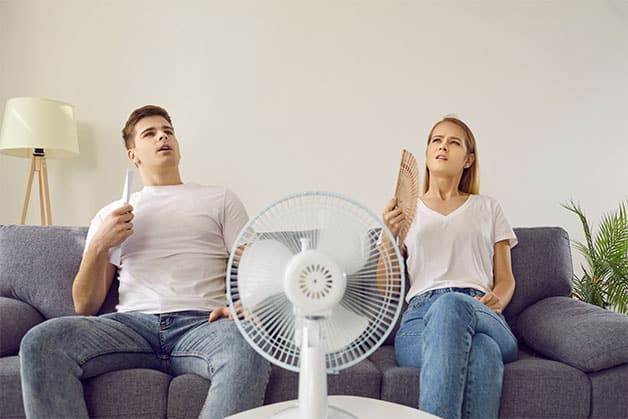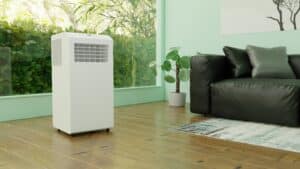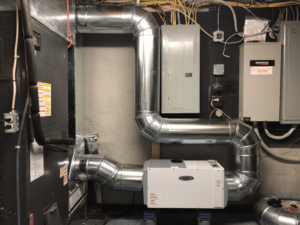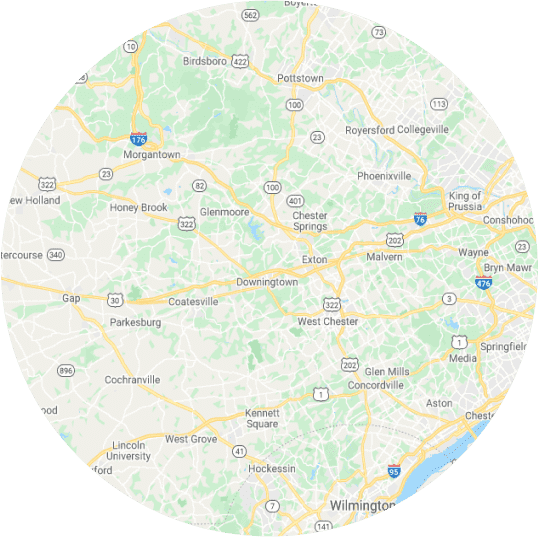Portable Dehumidifiers vs Whole-House Dehumidifiers: Which is Right for You?

There are a few options when it comes to dehumidifiers. Learn about the practical applications of all of them to make an educated investment in your home’s comfort.
Last Revised: January 31, 2024
Read Time: 6 min.
“It’s not the heat, it’s the humidity!”
If you’ve heard this phrase in your lifetime then you’re aware of just how oppressive a humid summer day can be. But what do you do when the humidity makes its way into your home? You’ve sealed closed all your windows and doors, and have your air conditioner running on high, but there’s an undeniable discomfort in your home’s air.
For most homeowners this is a nightmare situation, but at Mattioni, our professionals handle hundreds of homes experiencing the effects of humidity indoors every year.
Bringing a dehumidifier into your home is an effective way to keep your home’s air conditions healthy and comfortable.
In this article, we’re going to break down everything you need to know about dehumidifiers so that you can make the right decision for you.
Problems Indoor Humidity Causes
The most common issue with humidity in the home is that you don’t feel comfortable in your own living space. If you come inside on a humid summer day and don’t experience much relief, your humidity level is likely beyond the recommended threshold.
Mold and mildew can also begin to grow and eventually thrive in humid conditions, oftentimes in your basement. If you notice a strange musky smell or are experiencing allergy-like symptoms in parts of your home, it could be the first warning signs of mold. Persistent condensation on windows is another telltale sign of the early stages of mold growth.
Here’s something you might not know: creaking steps and swelling doors are also caused by humid air conditions. Not to mention the damage to your wooden piano and beautiful wooden furniture that seems to appear out of nowhere is also caused by humidity.
More importantly, humid air quality in your home can cause or worsen breathing problems like asthma within your home during the hot summer months.
How to Address the Lurking Problem of Humid Air in Your Home
Your first step is to check your current humidity level either by checking your thermostat or by using a hygrometer, which is a relatively affordable tool and can be purchased at your local hardware store.
If your home’s humidity levels measure over 60%, you’ve found yourself in the danger zone and are at risk for any of the issues mentioned above.
Does hearing this make you want to run directly to your nearest hardware store to purchase a dehumidifier? If so, your head is in the right place. For a decision like this, however, you’ll want to do your homework and learn about your options.
Here at Mattioni, our top priority is to make sure that you are educated enough to make the right decision for you and your family. So, let’s dig into the advantages and disadvantages of your options.
It’s your house after all; we’re just here to help you along the way.
What are my Dehumidifier Options?
Portable Dehumidifiers
The more well-known style of dehumidifier is the portable option, which sits on the ground and plugs into a nearby power supply. Portable dehumidifiers are usually a bit smaller than the whole-house option and dehumidify one room at a time.
The basic function of a portable dehumidifier is to attract warm air into its refrigerated coils using a fan. Once the air contacts the refrigerated coils, it produces condensation which is left behind in the appliance and the air is returned back into the room.
Whole-House Dehumidifiers
While you may have never heard of a whole-house dehumidifier, odds are you’ve recently breathed clean air from one of these systems at work, a restaurant, or a friend’s house without even knowing it.
Whole-house dehumidifiers either operate independently or can be ducted into the existing ductwork. They’re usually about 26”D x 14”W x 15”H in size, and 90 lbs. in weight, and require a ten-inch access point to your home’s ductwork if you’d like to connect it to your home’s ventilation system. They’re usually able to be concealed in your basement or attic.
What are the Differences Between Portable and Whole-House Dehumidifiers?
Besides the obvious difference in portability, there are a few other key distinctions between the two options. It’s best to consider all of them carefully before making your decision.
-
How Much Maintenance is Required?
Portable dehumidifiers have a water collection bucket to hold the water that has been removed from the air. This bucket needs to be regularly emptied for the appliance to continue running.
While some may consider this small task an afterthought, many homeowners would prefer to kiss dumping the water bucket goodbye. With a whole-house dehumidifier, there is no water bucket and the only maintenance required is cleaning its air filter every 90 days.
-
Is There a Difference in the Impact on My Utilities Bills?
Portable dehumidifiers should run for about 8 to 12 hours per day to get your home’s humidity level to a low or moderate level. Depending on the size of the appliance, it’s estimated to cost between $0.05 and $0.09 per hour. This adds up to anywhere between $12 and $32 per month.
On the other hand, the average monthly cost associated with running a whole-house dehumidifier is usually between $15 and $25. This means that the two options use roughly the same amount of energy.
It’s worth noting that Aprilaire, the whole-house dehumidifier brand used at Mattioni, has an air sampling feature to help with energy efficiency. This feature comes standard with all options.
The appliance runs a quick air quality test to decide if it should turn on at that moment to dehumidify the air. This leads to fewer on/off cycles, which is the stage when the appliance uses the most energy. Ultimately, the whole-house dehumidifier runs this test about three times per hour, which leads to five times fewer on/off cycles than a portable one.
This air sampling feature helps lower the operating cost of the whole-house option to levels similar to the portable option, making the cost comparison too close to call.
-
What Noise Levels Should I Expect?
Another notable difference between the two options is the noise level you should expect when running the device.
Your smaller, portable dehumidifier can sometimes produce a rattling noise, while a whole-house dehumidifier generates a low and faint hum that is inaudible between floors. Taking this into account prior to purchase can help reduce headaches in the future.
-
What are the Lifespan Expectancies of my Options?
One of the more important considerations that should likely be made is the expected lifetime of each option. Portable dehumidifiers usually run effectively for 3-5 years, while whole-house dehumidifiers can do so for up to 15 years.
Additionally, Mattioni’s whole-house dehumidifiers come with a 5-year parts warranty, and VIP members receive a 5-year labor warranty to help fix any issues that may arise early on in owning your new appliance. Typically, portable dehumidifiers are not accompanied by a warranty.
-
How Much Space is Treated by Each Option?
As you might suspect, a portable dehumidifier typically can only serve one room at a time. This may be a good option for those who only want to dehumidify the air in their basement.
On the other hand, whole-house dehumidifiers can treat the entire home, or selected rooms, depending on how it is installed.
For those homeowners who want to ensure that all the air circulating throughout their home, including rooms that routinely experience moisture like bathrooms and kitchens, is dehumidified then a whole-house dehumidifier makes far more sense.
-
What are the Cost Expectations of Dehumidifiers?
It’s no secret that a huge differentiator between the two options is price. The average portable dehumidifier costs between $300 and $500, while the price to install a dehumidifier with Mattioni ranges from $2,500 to $4,500 depending on the size of the space that needs treatment.
What does this mean for you? If price is the most important thing to you, then portable dehumidifiers may be the prudent choice. They are a good, quick, and affordable fix to your problem, so long as you don’t need too large of a space dehumidified.
And if you do need a large space treated, purchasing multiple portable units is always an option.
However, if you want a quieter unit that’s going to last up to five times longer and doesn’t require any day-to-day maintenance, then whole-house dehumidifiers are worth the investment for you.
Mattioni’s Expertise is Available for You
When it comes to moisture levels in your house, not taking action is an action. The reality is that if you notice humid indoor conditions from time to time, there is likely damage to your property, or worse: mold growth, taking place.
Dehumidifiers will help keep the air in your home comfortable and healthy to breathe.
If your existing thermostat isn’t capable of measuring humidity levels, we recommend getting an accurate measurement of your air moisture levels by scheduling a tune-up with the expert professionals at Mattioni.
If your humidity levels are approaching or over 60%, learning more about the options best suited for your home would be a wise decision that could prevent many future headaches.
Call today at 610-400-8510.







